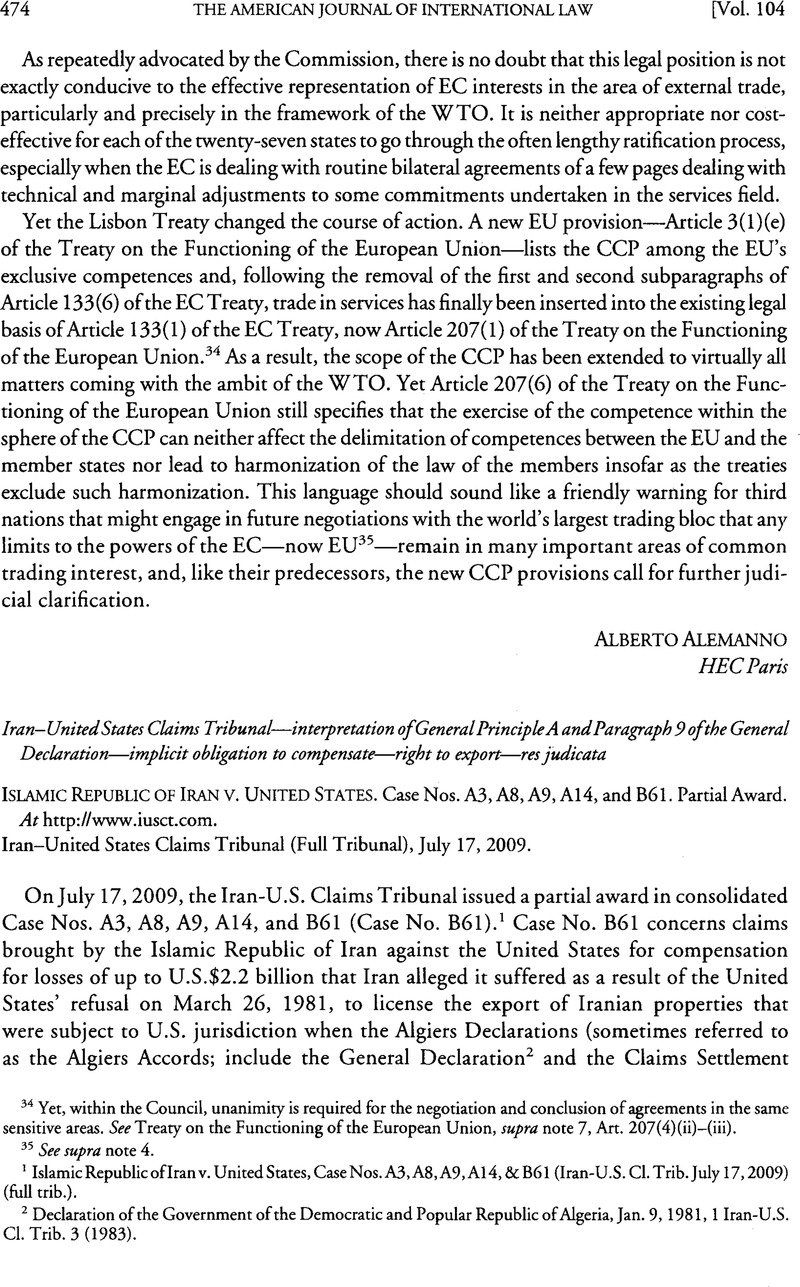No CrossRef data available.
Article contents
Islamic Republic of Iran v. United States. Case Nos. A3, A8, A9, A14, and B61
Published online by Cambridge University Press: 27 February 2017
Abstract

- Type
- International Decisions
- Information
- Copyright
- Copyright © American Society of International Law 2010
References
1 Islamic Republic of Iran v. United States, Case Nos. A3, A8, A9, A14, & B61 (Iran–U.S. CI. Trib. July 17, 2009) (foil trib.).
2 Declaration of the Government of the Democratic and Popular Republic of Algeria, Jan. 9, 1981, 1 Iran–U.S. CI. Trib. 3 (1983).
3 Declaration of the Government of the Democratic and Popular Republic of Algeria Concerning the Settlement of Claims by the Government of the United States of America and the Government of the Islamic Republic of Iran, Jan. 9, 1981, 1 Iran–U.S. CI. Trib. 9 (1983).
4 General Principle A states, in pertinent part, that “the United States will restore the financial position of Iran, in so far as possible, to that which existed prior to November 14, 1979.”
5 Paragraph 9 provides, in pertinent part, that “the United States will arrange, subject to the provisions of U.S. law applicable prior to November 14, 1979, for the transfer to Iran of all Iranian properties which are located in the United States and abroad.”
6 Islamic Republic of Iran v. United States, Case No. A15 (II:A and II:B), 28 Iran–U.S. CI. Trib. Rep. 112 (1992).
7 November 14, 1979, is the date that President Carter issued Executive Order 12, 170 freezing Iranian government assets held in the United States.
8 See supra note 6.
9 While Article 32(4) of the Tribunal Rules of Procedure requires arbitrators to sign awards, certain Iranian arbitrators have failed to sign various Tribunal awards in the past.
10 Tribunal President Survives Iranian Challenges, Mealey’S Int’L Arb. Rep., Apr. 2008, at 6.
11 Iran: Denial of Challenges to Skubiszewki ‘Totally One Sided, ‘Mealey’S Int’L Arb. Rep., May 2008, at 6.
12 Interpretation of Judgments Nos. 7 and 8 (the Chorzow Factory), 1927 PCIJ (ser. A) No. 13, at 23 (Dec. 16) (Anzilotti, J., dissenting).
13 Citing Panel Report, India—Measures Affecting the Automotive Sector, WT/DS146/R & WT/DS175/R, para. 7.60 (adopted Apr. 2, 2002); Lowe, Vaughan Overlapping Jurisdiction in International Tribunals, 1999 Austl. Y.B. Int’l L. 191, 202 Google Scholar; Reinisch, August The Use and. Limits of Res Judicata and Lis Pendens as Procedural Tools to Avoid Conflicting Dispute Settlement Outcomes, in 3 The Law and Practice of International Courts and Tribunals 37, 71 (2004)Google Scholar.
14 The Tribunal seems to have recognized this point itself:
If the Tribunal determines that [A15(II:A)] is not res judicata, then the Tribunal will next have to consider whether it has inherent jurisdiction to overrule, or depart from, its prior awards to the extent that such decisions carry precedential value only and do not have the status of res judicata. (Para. 113)


